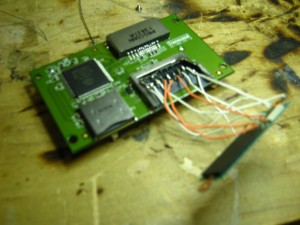Our Intern vs. a Smashed Panasonic HDC TM55P: A Data Recovery Case Study

Recovering data from failed electronic storage devices is an exercise that rewards those who like to tinker, reverse engineer, and solve problems.One of our interns, UW-Madison student Jakob Gillberg, demonstrated his aptitude when confronted with a smashed camcorder, a Panasonic HDC TM55P.
The device stored its pictures and movies on an internal 8 gigabyte proprietary memory chip. The chip was connected to the camera’s motherboard via a unique ribbon interface.The ribbon held nine wires, and there were 10 leads on the circuit board. Since the camera no longer functioned, Jakob’s job was to construct a reader for the chip. He’d have to separate the ribbon connection and solder 9 wires between the chip and a common chip reader.
Panasonic’s technical documents did not reveal the board layout, so Jakob had to probe the circuit and make the right connections using some good old deductive reasoning. With 9 wires and 10 possible connections, there was only one right answer among over 3 million possibilities. An incorrect connection could mean loss of data on the chip, so it had to be right the first time.
Jakob, who is studying electrical engineering and computer science, experimented with two Transcend TS-RDP8K card readers and relied on an alligator clip to get a working setup. Once he was sure the connections were correct, he got a 100 percent read from the chip – a successful data recovery!
The University of Wisconsin – Madison is not only the alma mater to several of Gillware’s founders; it continues to strengthen our lab by attracting outstanding student interns such as Jakob.

